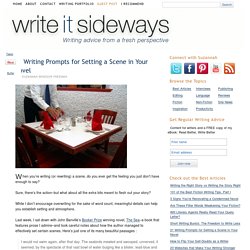

Al's Writing Block: Writing: How to Describe a Room. I've noticed lately in the stats that people have been actively searching for "how to describe a room.

" Even though I had done a writing prompt that called for using the description of a room, I never did go over the particulars of describing locations. So for anybody looking for some specific answers, here are my thoughts on describing interior settings, for fiction and prose. First and foremost, you got to ask yourself, what importance is the room or setting to the story or characters? If the room is only there for a brief passing scene, it may just suffice to say "so-and-so went into the broom closet. It was dark, cramped, and loaded with brooms. " For more significant settings, where you really do want to paint the picture in the readers' heads and firmly establish a sense of space or ambiance, then of course you'll want to dig into more details. The objects in a room - furniture and stuff - may or may not factor into your scene.
In summary... Do: Settings in Your Novel That Work As Triggers. When choosing settings for your scenes, you want to think about the kinds of places that will allow the emotions, needs, dreams, and fears of your characters to come out.

Certain places will trigger these things to come to the surface and will stir memories. Your character has a past, and even if she never visits any of the places in her past in your novel, other places can draw out feelings and memories. This happens to us all the time. Of course, if you are putting your characters in places they’ve been before, or they are living in the same town their whole life, those memories and feelings are closer to the surface. The point it, you want to use your setting to help bring out your themes, drive your plot, and reveal character. In last week’s post I had you think about the places in your past that evoked special memories or feelings.
Ask Your Character What might be special about this place that a person passing through might not notice? Setting That Triggers Memories. Writing The Perfect Scene: Advanced Fiction Writing Tips. Having trouble making the scenes in your novel work their magic?

In this article, I’ll show you how to write the “perfect” scene. Maybe you think it’s impossible to write the perfect scene. After all, who can choose every word perfectly, every thought, every sentence, every paragraph? What does perfection mean, anyway? Honestly, I don’t know. But structure is pretty well understood. The Two Levels of Scene Structure A scene has two levels of structure, and only two. The large-scale structure of the sceneThe small-scale structure of the scene This may seem obvious, but by the end of this article, I hope to convince you that it’s terribly profound. Before we begin, we need to understand how we keep score.
Your reader is reading your fiction because you provide him or her with a powerful emotional experience. If you fail to create these emotions in your reader, then you have failed. 10 Tips on Writing Strong Scenes For a Novel or Story. Any story or novel is, in essence, a series of scenes strung together like beads on a wire, with narrative summary adding texture and color between.

A work of fiction will comprise many scenes, and each one of these individual scenes must be built with a structure most easily described as having a beginning, middle and end. The beginning of each scene is what we’ll address here. The word beginning is a bit misleading, since some scenes pick up in the middle of action or continue where others left off, so I prefer the term launch, which more clearly suggests the place where the reader’s attention is engaged anew. Visually, in a manuscript a new scene is usually signified by the start of a chapter, by a break of four lines (called a soft hiatus) between the last paragraph of one scene and the first paragraph of the next one, or sometimes by a symbol such as an asterisk, to let the reader know that time has passed.
Where are my characters in the plot? 1. 2. 3. 4. 5. 6. 7. 8. 9. 10. 21 Writing Prompts for Setting a Scene in Your Novel. When you’re writing (or rewriting) a scene, do you ever get the feeling you just don’t have enough to say?

Sure, there’s the action–but what about all the extra bits meant to flesh out your story? While I don’t encourage overwriting for the sake of word count, meaningful details can help you establish setting and atmosphere. Last week, I sat down with John Banville’s Booker Prize winning novel, The Sea–a book that features prose I admire–and took careful notes about how the author managed to effectively set certain scenes. Here’s just one of its many beautiful passages : I would not swim again, after that day.